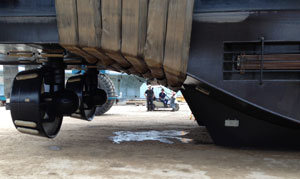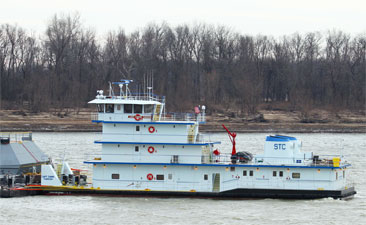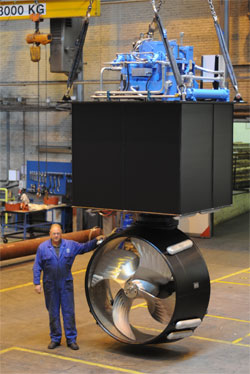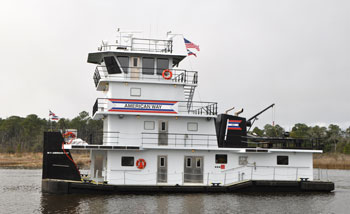Although it’s one of the nation’s largest inland operators, American Commercial Lines (ACL) hadn’t ordered any new vessels since 1982. When the Jeffersonville, Ind.-based company finally acquired two new pushboats this year, those vessels were equipped with z-drive propulsion systems.
The azimuthing-stern-drive design debuted on the inland rivers only about six years ago. Suppliers said the recent deliveries to ACL, Southern Towing and a few other operators in 2014 are an indication that the towing industry is finally embracing the new technology.
The birthplace of many of these new towboats is the Bayou La Batre, Ala., area, where three shipbuilding businesses are producing the high concentration of z-drive inland vessels.
 |
|
(Photo courtesy Steiner Construction) The z-drive systems before the boat was launched at Steiner Construction Inc. |
In the spring of 2014, Steiner Construction Inc. delivered a pair of 2,000-hp boats to ACL, which plans to exercise options for more. The 70-foot American Way went to work for ACL in the Baton Rouge, La., barge fleet, while the 75-foot American Spirit is headed for the Gulf Intracoastal Waterway between New Orleans and Houston.
Z-drives, which provide a 360° directional option, are more efficient than a traditional rudder configuration because they focus all of the engine’s force toward pushing the boat in the direction the pilot wants. With a traditional rudder, much of the thrust gets deflected — and wasted — as the water is directed away at an angle to create resistance and drag.
Compared to the rest of the ACL fleet, the two new boats operate more efficiently, respond to commands quickly and are easier to navigate, said David Abney, marine superintendent for ACL’s southern division.
“It’s everything we expected and more,” Abney said. “You can get the work done faster and safer at the same time, because of the maneuverability. It’s a lot easier to handle the barges too. You’re not losing any thrust. You always get what we call ‘clean water.’”
The designer of the two new ACL vessels was Gulf Breeze, Fla.-based Sterling Marine LLC. As part of the project, Steiner Construction acquired the rights to and modified an original z-drive design from Rodriguez Shipbuilding Inc. in Coden, Ala. ZF Marine supplied the z-drives.
In addition to the greater maneuverability and the safety benefits, the z-drives improve fuel efficiency by allowing the operator to keep the boat moving in exactly the intended direction.
“That’s where the value of the z-drives will really show up, we believe,” said Bill Foster, ACL’s vice president of boat maintenance. “We looked at the whole life-cycle cost and see potential value — a half-million dollars a year over a conventional boat. Sixty to 70 percent of that is fuel, and the rest of it is maintenance that I’m comparing with our 30- to 40-year-old tugboat fleet.”
The pioneer of using z-drives for inland river work was Southern Towing Co. In 2008-09, the Memphis, Tenn.-based operator debuted the 3,800-hp Frank T. Stegbauer, David Stegbauer and Scott Stegbauer. Convinced that the z-drive configuration was the way to go, Southern has added more of the vessels over the years. Its three newest z-drives are the 2,300-hp Paula Fortier, Theresa Echols and, most recently in 2014, Capt. Tommy Parrish.
Another large operator, Marquette Transportation, said it will take delivery of three z-drive towing vessels for its Gulf-Inland division this year. The builder is Bayou La Batre-based Master Marine.
 |
|
(Jeff L. Yates photo) |
|
Capt. Tommy Parrish at work on the Ohio River. Featuring Thrustmaster z-drives, the boat is a recent delivery for Southern Towing Co. |
ACL has been able to observe the z-drives’ performance in a variety of jobs. That’s because American Way is busy moving barges around within the Baton Rouge fleeting area, while American Spirit has been assigned to configuring and pushing tows along the Gulf Intracoastal Waterway. Abney said the z-drives reduce the amount of backing and pivoting. The older boats are slower to change direction.
“You definitely don’t have to flank as much,” Abney said. “You get the work done faster because there is no reaction time really from your ‘full ahead’ to ‘full astern’ — and you do a lot of that. You might (wait) 45 seconds with the other one.”
He said American Spirit should be able to move cargo more efficiently for the company.
“In the straight-ahead work, it’s going to be faster and more efficient,” he said. “In the fleets and on the Intracoastal, you have to build your own tow. It will make our in-and-out times a lot faster, so we won’t have as much time in port.”
Abney himself piloted American Way from the Alabama yard to its new Baton Rouge home. The crew was amazed at the reaction time of the steering and propulsion systems. He noted the obvious safety benefits.
“When you do an emergency stop with it, it’s like it’s got brakes. I have never seen a boat stop that fast,” Abney said. “In regular flat water, you can stop in the length of the boat.”
Steiner Construction owner Bubba Steiner said other operators are bound to recognize the operational benefits of using z-drives on the inland rivers. The Southern Towing vessels were built at Steiner’s father’s business, Steiner Shipyard Inc. ZF Marine also has supplied z-drives to Southern.
 |
|
(Courtesy ZF Marine) |
|
A well-mount azimuth thruster, model ZF WM5000 AT, is ready for delivery from ZF Marine’s production facility in the Netherlands. This unit was on its way to the U.S. for use on an inland towboat. |
“It was led by Southern doing it, and then there was enough data out there,” Steiner said. “Now ACL, I would say they sure are giving it a good test. Your big operators and a couple of your small operators are looking at it. You weigh the fuel savings and you have the safety and the performance.”
David Santos, ZF Marine’s commercial craft segment manager, said his company has made improvements to the equipment in the six years since the Stegbauer boats debuted the concept. Santos said inland operators are becoming more and more aware that z-drives are a viable choice.
“It’s clear that this trend is still being dissected and evaluated,” Santos said. “We’re taking these fundamentals (and) applying new engineering concepts and making them better and making them stronger and lowering the cost.”
This year, Rodriguez Shipbuilding is delivering Capt. Frank Banta Jr., a 2,600-hp z-drive river towboat, to Chem Carriers. Rodriguez in 2011 built the 1,400-hp z-drive Brooke Banta for the Sunshine, La.-based operator. ZF Marine supplied the z-drive units.
Yard owner Joey Rodriguez said river operators for years had been skeptical about building z-drive boats — and not just because of the extra expense.
“They’ve always been leery of the kort nozzles because of the shallow areas of the river. The z-drive units are tucked up in the boat. There is a focus more and more toward shallow-draft designs,” Rodriguez said. “You pick up 33 percent more thrust with the same fuel burn. … The z-drive is going to give you 27 to 30 percent savings on fuel cost because of the kort nozzle around the z-drive.”
Now those operators are placing orders.
“It’s catching on all over,” Rodriguez said. “The proof’s in the pudding. The captains are just raving about the maneuverability.”

